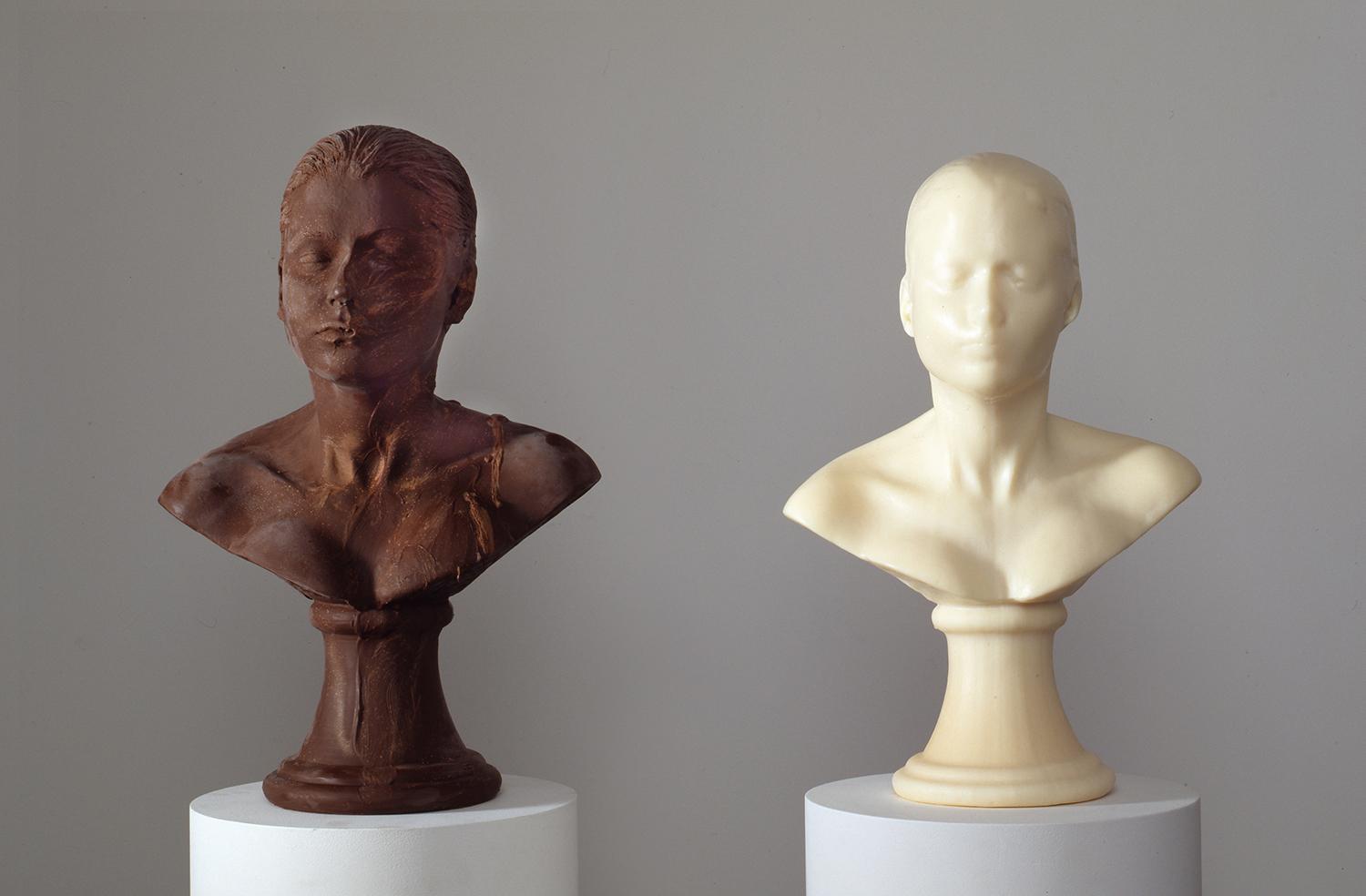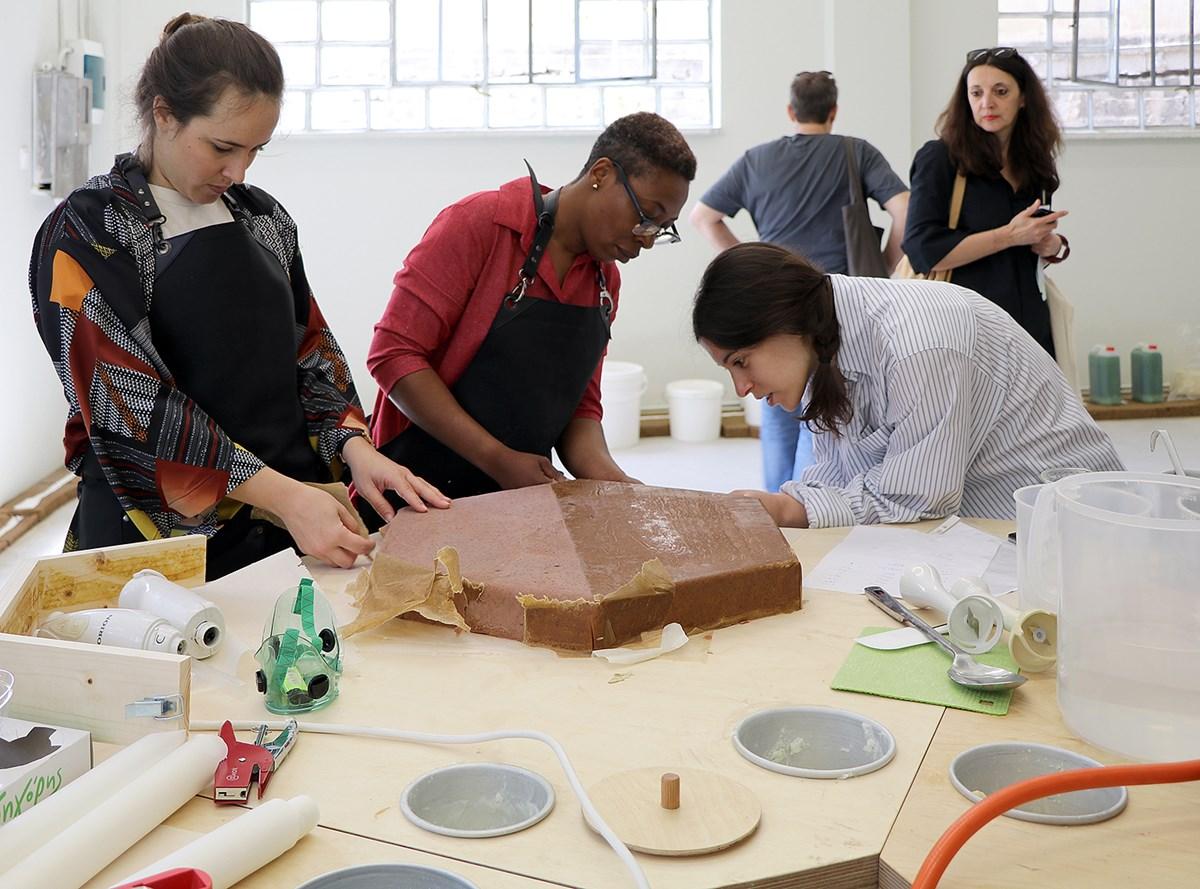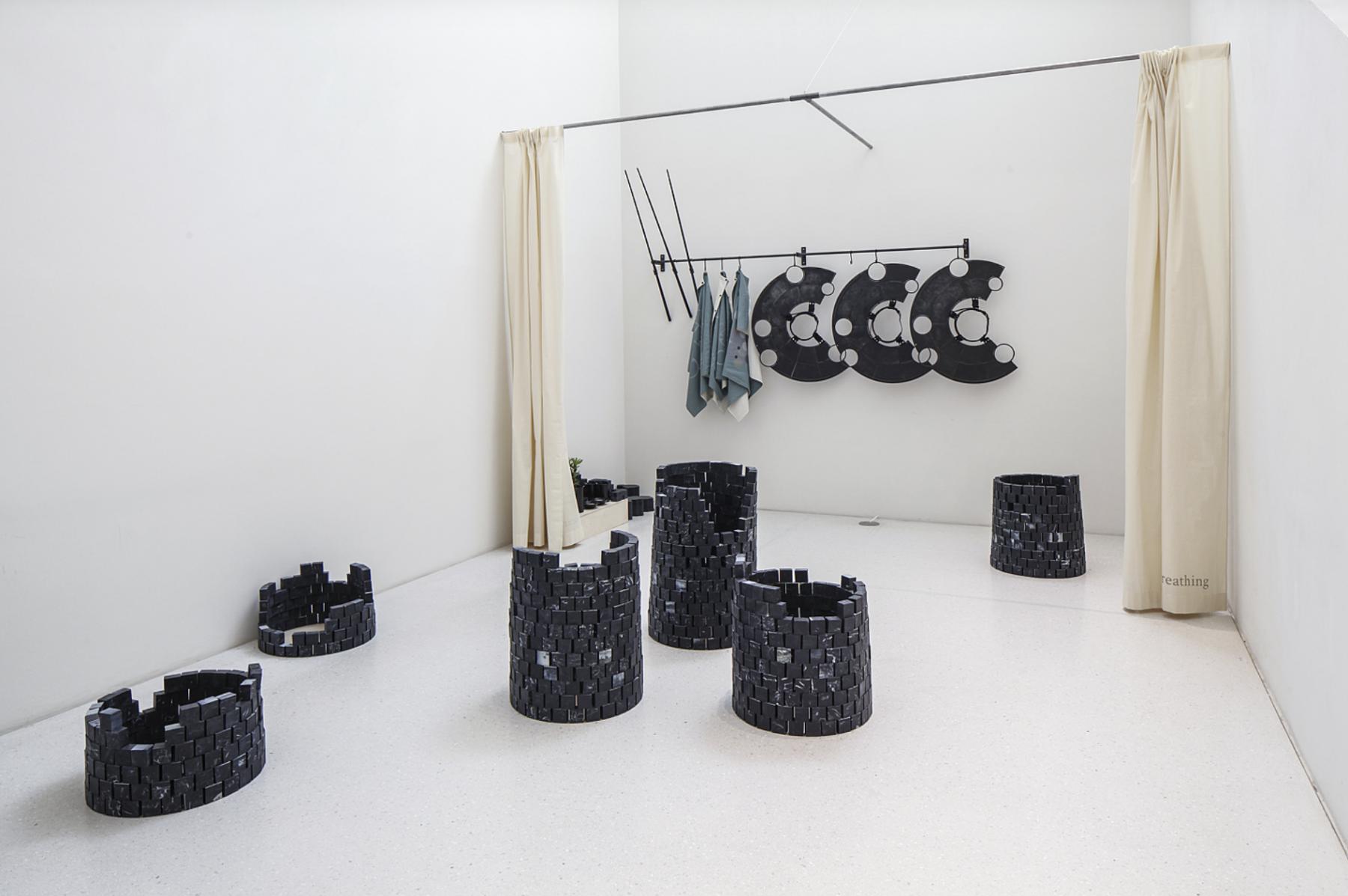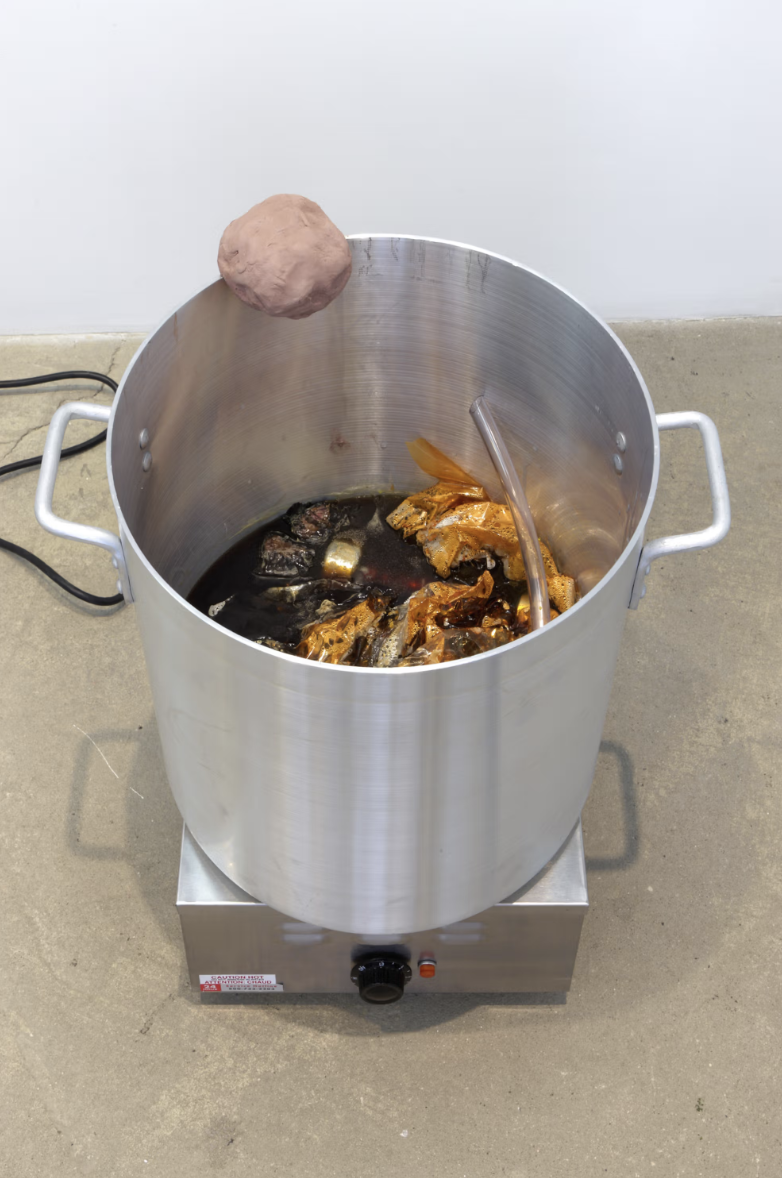Soap: the most quotidien of the quotidien; also, a nearly 120 billion USD global industry1 playing both to aspirational consumerism and anxieties of contamination as a reminder of the messiness of our mortal bodies; also, a crystallization of hygiene as a category far exceeding health-related concerns as a phenomenon tied to constructs of race, class, gender, and sexuality; also, art.
Soap has appeared as a motif throughout art history—from seventeenth-century Dutch oil painting to twentieth-century Surrealist photography—yet the past three decades have marked a shift from the visual representation to the direct incorporation of soap in installations charged with familiar sensory resonance. Though rife with symbolism, soap far exceeds metaphor as a tactile, aromatic medium that confronts the ontological object-ness of the precious artwork. Whether defamiliarizing soap or reveling in its familiarity, artists across contexts approach the substance through distinct tactics, yet with shared attention to materiality. As a prop implicated in the physical and ideological maintenance of the illusory boundary of the skin, soap confronts the politics of purity. Materially, while also symbolically, soap enables artists to question prevailing fantasies of the discrete, sealed-off human body without playing into the identity politics of figurative representation.
The elusive history of soap dates back nearly 5,000 years, with records of soap-like products in Mesopotamia, Egypt, Greece, and Rome. Across cultures for millenia, soap has been made from three common ingredients: an animal fat or plant oil mixed with water and an alkaline such as lye, perhaps from wood ash. Soap was concocted in small batches, often at home using cooking byproducts, primarily for laundry and other chores, rather than bodily hygiene.2
Late nineteenth-century industrialization fueled the shift from soap-making as an alchemical craft incorporating residues into a mass-produced commodity. United States-based Procter & Gamble and Colgate gained traction through advertising campaigns aligning cleanliness with health, and health with morality in the early twentieth century. Meanwhile, traditional soaps were increasingly replaced by chemically engineered, multi-ingredient detergents primed for mass-consumption—the sort of synthetic soap-relatives that dominate drugstore shelves today.
Consumer trends in soap usage reflect shifting concepts of hygiene as a culturally and historically specific phenomenon shaped by evolving spiritual, scientific, and social conceptions of the body. Soap permeates the public consciousness with promises far exceeding hygiene, as evidenced by the age-old threat of punishing vulgar language by washing a mouth out with soap, not to mention adages like “cleanliness is next to godliness.” The slippage between the rhetoric of “cleaning” and “cleansing” evokes the slippage between physical and moral “purity” as a modernist ideal associated with whiteness as a racialized construct—from the continued legacy of racist advertising tropes to the proliferation of soaps containing literal whitening agents such as Unilever’s “Fair & Lovely,” renamed “Glow & Lovely” just in 2020.3
Materially, soap enables artists to question prevailing fantasies of the discrete, sealed-off human body without playing into the identity politics of figurative representation.
The rise of soap as a medium—rather than merely a subject matter—in contemporary art over the last thirty years recalls a mid-twentieth-century trend of soap-carving in the U.S. and abroad, when Procter & Gamble sponsored annual competitions to popularize the mass-produced commodity.4 During the Great Depression, in a jobless era of growing resentment toward industrialized production, P&G ironically advanced corporate interests masked by the homespun appeal of soap-carving as an accessible, inexpensive artisanal craft. Continuing annually into the 1940s, the “National Soap Sculpture Competition in White Soap” specifically promoted Ivory soap, the all-white bars purportedly named after a passage from the book of Psalms.5 The slogan “99 44/100 percent pure”6 further advanced the product as a sort of spiritual conduit to inspire consumer reverence. Simultaneously, marketing campaigns positioned “Ivory” as an agent of “civilization,” effectively advancing a racialized construct of purity with eugenic overtones.7
Despite the participation of high-profile judges like Mount Rushmore-sculptor, Gutzon Borglum, efforts by artists like Brenda Putnam ultimately failed to legitimize soap carving as a fine art form. Instead, the competition perhaps reinforced connotations with the domestic commodity as pedestrian and provisional, given that the winning entries did not remain soap, but rather were cast in porcelain or bronze—elevated through these more conventional, durable materials—to be sold through mail order.
Since the 1990s, artists have embraced the very associations that once disqualified soap as a reputable artistic medium—associations with mundane consumerism, with craft as a feminized domestic activity, with the sheer filth of bodies. Though the wax-like malleability of heated soap is conducive to sculpting, the shiftiness of the substance ever-threatening to dissolve challenges art historical logics of preservation likewise crucial to the commercial viability of art. Whereas artists like Miroslaw Balka, Song Dong, and Chu Yun have presented dwindled remnants of bar soap as readymades charged with symbolism, sculptors like Meekyoung Shin and Janine Antoni have more radically questioned the permanence of the art through process-oriented approaches.
Shin leverages the ephemerality of soap to complicate museological fantasies of fixity premised on human-centered fantasies of control. Recalling childhood memories of soap-carving in primary school in Korea, Shin creates soap-cast replicas of iconic statues, collapsing distinctions between high and low brow. To inaugurate the public art series, Written in Soap: A Plinth Project (2012-), Shin situated a soap-cast copy of a statue of the Duke of Cumberland in London’s Cavendish Square, on the very plinth occupied by the original equestrian sculpture from 1770 to 1868. Over the course of a year, the dissolution of the increasingly illegible simulacrum at the whim of the elements dramatized not only the material instability, but also the ideological fragility of authoritarian statues with supposedly eternal meaning. In a sense, Shin confronts both state-sanctioned public art and soap as instruments of “civilization,” considering legacies of the imperial weaponization of hygiene as a mode of biopolitical control geared to reinforce racist, misogynistic, homophobic, and xenophobic hierarchies.8

Janine Antoni, Lick and Lather, 1993. Sourced via.
Antoni likewise mobilizes the transience of soap to confront classical statuary as an exclusionary Euro-Western genre. Lick and Lather (1993) consists of seven soap-cast busts representing the artist, which she used to “lather” herself in the shower. The eroded sculptures are displayed alongside a row of seven likewise imperfect, “licked,” chocolate-cast busts. Confronting the historical relegation of women to muses rather than makers, Antoni compromises the legibility of her soapy self-images, while inverting the premise of soap as a cosmetic prop geared toward the maintenance of outward appearances. Antoni leverages soap not to “wash” or “clean,” but to “lather,” a sensual activity that evokes pleasure within a mundane ritual here conflated with her intensely embodied mode of sculpture. The blurred forms index her engagement and thus deny the erasure of her artistic labor, conjuring the feminist legacies of artists like Mierle Laderman Ukeles, whose “Maintenance Art” of the 1970s confronts systemically obscured gendered labor systems.
Where both Shin and Antoni undercut the permanence of statue, Beirut-born Palestinian artist Mona Hatoum invokes the instability of soap to problematize colonial logics of mapping premised on the supposed fixity of geopolitical borders. In Present Tense (1996), the artist maps the land supposedly “returned” to Palestine through the Oslo Peace Agreement across 2,200 blocks of soap embedded with red beads. Hatoum uses not just any soap, but rather engages collective cultural memory through Nablus soap, a traditional Palestinian olive oil-based substance dating back to the 10th century. The use of this particular soap in this site-specific installation within a former Nablus factory shut down by Israeli forces evokes the endurance of collective heritage despite ongoing colonial incursions epitomized by the fragmented map parsed across discrete, rough-hewn cubes.

Otobong Nkanga, Carved to Flow (2017). Exhibition view: documenta 14, Athens (8 April–16 July 2017). Photo: © Wim van Dongen.

Otobong Nkanga, Carved to Flow, 2017. Installation view: Neue Galerie, Kassel, documenta 14. Photo: Liz Eve. Sourced via.
By engaging with culturally specific pre-industrial traditions of soap-making premised on intense material attunement, artists like Hatoum and Otobong Nkanga set forth soap as a layered repository of material histories encapsulating relations across space and time. For Nkanga, soap is like clay as a tangible tether to the earth that holds embodied knowledge, while simultaneously conjuring the exploitative geopolitical dynamics of material extraction. The Nigeria-born, Antwerp-based multimedia artist engages with ancient traditions of both Nablus and Aleppo in Carved to Flow (2017-), a participatory, multi-phase, transcontinental project mobilizing the production, movement, and commerce of “O8 Black Stone” soap, which the artist envisions as “a sculptural piece that can reflect on the soil, the earth, oil, wars, ecology.”9 By incorporating oils, butters, lye, and charcoal sourced from localities across the Mediterranean, Middle East, and Africa, the bars of soap produced in Athens during documenta 14 implicate legacies of trade in the Middle Ages, when Christian crusaders brought soap from Syria to Europe, spurring the development of a luxury market.10 Nkanga further enacts an expansive material network by transporting the O8 soap to Kassel, Germany, where the bars were sold for twenty-five USD each, with all proceeds funding longer-term community-based projects in Nigeria. In foregrounding systemically obscured labor systems in denial of detached consumerism, this project—which engages with art institutions without wholly entering the art market—lends appreciation of material engagement as a sort of ecological praxis of thinking across scales, both spatial and temporal, while pushing against discrete territorial logics of the nation-state.
Coupled with the tactility of soap, artists further engage the senses through smell as a visceral register that challenges Modernist ideals of disembodied visual experience, while confronting museological standards of white-cube sterility. Smell is crucial to the work of Hatoum, for example, insofar as the aroma of Nablus soap heightens the affective weight of Present Tense specifically for visitors with ties to the material tradition. The ineffability of smell, with its potent capacity to evoke memory, counters the sort of empirical ethos of mapping as a territorial instrument of domination. Saudi Arabia-based, Yemeni artist Sara Abdu likewise leverages the culturally specific resonances of smell, specifically the “the smell of death” in Now That I've Lost You in My Dreams, Where Do We Meet? (2021/2024), through the creation of soap from sidr powder and camphor crystals to recall Islamic cleansing rituals in preparation for burial.11
Multimedia artist Rashid Johnson incorporates black soap and shea butter as aromatic substances of West African origins popular amongst Black diasporic communities in New York and beyond. Johnson conjures the layered dimensions of black soap as both a “signifier” and a material means of care: “It’s for people with sensitive skin, so I’m talking about a sensitive issue, about sensitive people, and using this material that’s meant for sensitive people.”12 In Anxious Audience (2019), Johnson layers a mixture of black soap and wax on white tile—a charged backdrop evoking the interplay between the sleek, sterilized aesthetics of modern art and modern hygiene. Through the faces frenetically etched into the splattered pigment, the wall-based work evokes certain unease or “anxiety,” while denying the neat visual order suggested by the ceramic tile as a sort of modernist grid, thus challenging associations with soap as an agent of “purity.”
While on one hand evoking the imposition of hygiene in the name of discipline—under the guise of “correction” within “correctional facilities”—soap also embodies cultural anxieties of contamination—anxieties often with racist, xenophobic, and misogynistic underpinnings.
In a fundamental sense, the very integration of smell—regardless of the associations with a particular odor—confronts the codified scentlessness of art institutions that prize visual experience. Through olfaction as a register associated with non-hegemonic subjects in liberal humanist thought, such projects amount to epistemological interventions that question the forms of knowledge historically privileged by capital-A Art, while positing the potential to embrace embodied experience. The surge in multisensorial installation in the twenty-first century reflects what has been dubbed a “material turn” in contemporary art, with renewed investments in hands-on, process-oriented modes of making, in conjunction with materially immersive encounters that render tangible the conditions of corporeal permeability.
Shin goes a step further in challenging ocularcentrism, not only through the integration of smell, but also through the invitation to touch in Translation—Toilet Project, 2006–2007. Breaking the foremost Euro-Western convention of art as untouchable, safeguarded from human grime, Shin placed soap-cast Buddha figurines and Venus busts for handwashing in public toilets in Seoul and London. Later exhibiting the eroded forms in sanctioned institutional spaces, Shin links the elevated space of the art gallery to the abject domain of the toilet, while underscoring the potential use value of art exceeding aesthetics. Like Nkanga, Shin complicates the patriarchal prototype of the singular artistic genius through participation, in this case conjuring the collective processes through which cultural meaning is shaped—here both literally and metaphorically. In the work of Shin, meaning is not set in stone, but rather in soap, which is to say not set at all.
Multimedia artist Jesse Krimes likewise prompts thinking beyond the insular walls of the art gallery by leveraging prison-issued soap, which embodies the ongoing infliction of regimented hygiene to reinforce social hierarchies within such disciplinary institutions and beyond. Denied access to conventional artistic materials in prison, Krimes developed a resourceful method of transferring moistened headshots of both incarcerated individuals and celebrities onto whittled chunks of soap then smuggled out inside decks of playing cards. In Purgatory (2009), the faded visuals compromise the identifiability of the subjects, while the ephemerality of soap undercuts the objectivity associated with photography as a tool of visual capture central to histories of criminalization. Like Krimes, Burmese artist Htein Lin resorted to Shwe Wah soap as a sculptural medium charged with political resonance while incarcerated in Myanmar, which compelled his later creation of a modular map of the country in Soap Blocked (2016), an installation simultaneously eliciting comparison with Hatoum’s critique of geopolitics.

Anicka Yi, Cobweb, 2014. Courtesy the artist and Bortolami Gallery. Clear glycerin soap, 1 crumpled sheet (dimensions 39″ x 39″) of orange cellophane paper, 1 whole orange peel, 2 5lb chrome barbells, 5 strips of clear rubber tubing, 1 hand full of white shredded fiberglass, lump of red/brown clay, 1 hand full of light green/ grass green metallic plastic or glass beads, handful pickled roses, shards of mahler’s death in venice album, pieces of honeycomb, 1 legal cease and desist letter, bat virus, 3 broken nails, 23 × 15 × 15 in (58 × 38 × 38 cm). Sourced via.
While on one hand evoking the imposition of hygiene in the name of discipline—under the guise of “correction” within “correctional facilities”—soap also embodies cultural anxieties of contamination—anxieties often with racist, xenophobic, and misogynistic underpinnings. Interdisciplinary artist Anicka Yi, whose interest in hygiene predates the COVID-19 pandemic, channels the alchemical origins of soap-making as a craft premised on deep appreciation for material agencies. In Cobweb (2014), the Seoul-born, New York-based artist brews a decidedly inedible concoction in a stock pot-turned-cauldron atop a hot plate with ingredients such as “Clear glycerin soap,” “1 whole orange peel,” “1 legal cease and desist letter,” “lump of red/brown clay,” and so on. This amalgamation of found materials denies distinctions between the organic and the synthetic, a dichotomy premised on fantasies of humanity as somehow separate from the discrete, in turn exploitable, domain of nature. Most notably, the inclusion of “bat virus” together with “glycerin soap” plays upon fears of infection by unseeable microbes, which recalls the inflammatory xenophobic rhetoric of “foreign” contamination of both the individual body and the national body rampant during the COVID-19 pandemic.
Through this set-up of familiar cooking receptacles, rather than more sterile laboratory equipment, Yi calls into question associations with “bat virus” and “glycerin soap”—both as phenomena implicated in the imagination of bodily boundaries. The uncovered, actively brewing aromatic concoction denies desires for containment, as if to suggest the inevitability of bodily permeability, while embracing the uncertain alchemical interactions of the eclectic materials. Insofar as viruses prompt recognition of the impossibility of purity, Yi complicates fantasies of soap as an infallible safeguard against contamination as a social construct.
Puppies Puppies, the artistic persona of Jade Guanaro Kuriki-Olivo, explores the compulsory use of antibacterial hand sanitizer as a substance conducive to fictions of the sealed-off human body, despite the paradoxical risks of such potent products in the elimination of both “good” and “bad” bacteria—itself a problematic human-centered distinction that overlooks threats to the broader ecosystem.13 Through the installation of Purell-brand dispensers for use in galleries as readymades, the artist departs from the Duchampian premise of uselessness, while effectively defamiliarizing the ubiquitous product, which gained unprecedented visibility amidst the recent pandemic. The Purell brand—synecdoche for hand “sanitizer”—evokes the chemical-addled pursuit of cleanliness as a simultaneous form of civic performance and accelerated late-capitalist consumerism. These Purell dispensers—art objects that insist on remaining Purell dispensers—prompt a deceptively complicated question: What exactly is promised or achieved through each pump of gel as a conditioned performance that seldom merits conscious consideration?
Though the use of antibacterial hand sanitizer might seem to distinguish Puppies Puppies from the artisanal approaches of artists like Nkanga, these projects converge in the evocation of soap-like substances as primed to explore the imbrication of health-related crises and environmental crises, all entangled with legacies of colonialism, extractivism, and systemic social inequities. Simultaneously, artists like Johnson invite thinking beyond soap as an instrument of biopolitical control to envision the possibilities for care through soap as a tactile locus of collective cultural histories.
To engage with soap, whether alchemically produced or chemically manufactured, is to engage with the body. Yet these soapy interventions evoke “the body” not as some supposedly discrete individualistic fortress, but rather as a porous entity enmeshed within the material world. Across these process-oriented projects and participatory installations, soap perhaps becomes a reminder of corporeal permeability, and the very limits of human control, rather than a mechanism of dominance—which amounts to a rather radical, fundamental political proposition in an age of layered, imbalanced precarities.